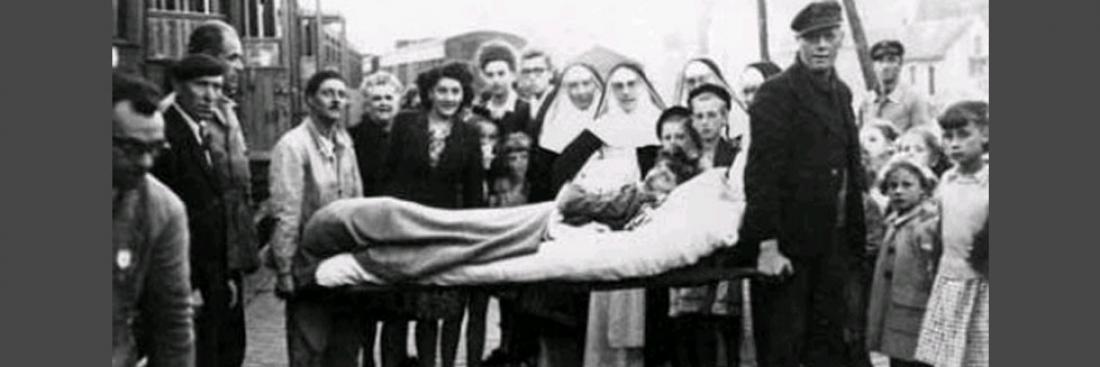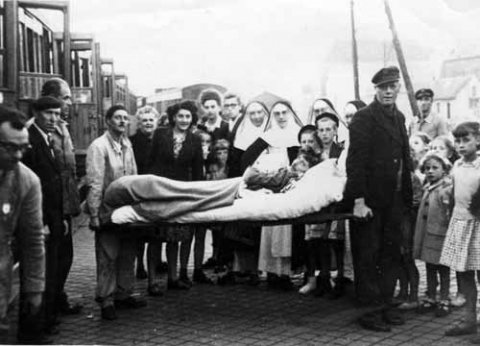Saint Pol Internment Camp
Sous-titre
Prisoners at home...

Prisoners at home...
Although France had been liberated, the Saint-Pol internment camp continued to hold those who did not want to leave. September 1944: the North liberated itself, and the noose was tightening around the Germans who were holed up in the Dunkirk Pocket, imprisoning no fewer than 12,000 Germans and 25,000 civilians. A truce was concluded on 4 and 5 October so as to evacuate almost all the civilians because a few uncooperative people, considered ”unproductive mouths to feed”, refused to leave. In order to better control them (and to get a hand on their food supplies), the occupants created four internment camps on 14 February 1945 at Coudekerque-Branche, Malo, Rosendaël and Saint-Pol.

The people of Saint-Polois were unable to return home until the end of April 1945. Photo from the ”Phare Dunkerquois”
A strict organisation: At Saint-Pol, the civilians were locked up between rues Ferrer, Etienne Dolet, Victor Hugo and Faidherbe. The perimeter was fenced off with barbed wire. Captain Schmidt was named commander and had accommodation at the camp. He was given a civilian deputy, the Mayor of Petite-Synthe, Mr Albert Barbary, who was given a building at 5 rue Ferrer to set up his administration. The mayor was kept very busy. His job required him to perform roll call of the internees, care for the camp's appearance, distribute food and serve as a ”justice of the peace”. Furthermore, being the only magistrate who remained in the Dunkirk Pocket, he performed mayoral functions. His task was difficult because the Saint-Pol camp held 110 internees from the town, Fort-Mardyck, Grande-Synthe and Petite-Synthe.
Hard everyday life: The Germans required the internees to work to earn meagre rations. They were paid for their work, but at the rate applied by the occupying armies (8 francs an hour), starting at age 14. The German admiralty did not accept any ”unproductive mouths to feed”: women were requisitioned for laundry and sewing work. They had to make clothes for the troops, who lacked everything. The men were employed in the construction and reinforcement of the fortifications as well as in farm work, as food was in terribly short supply. They organised the best they could and the population raised many animals to improve their everyday diet: over 600 rabbits, nearly 400 chickens, ducks, geese, cows and horses. There was a shortage of everything and everybody had to use their imagination - for example, to mill grain, the residents made a makeshift mill using a bicycle, and as the cigarettes sold by the Germans were too expensive (20 francs apiece), they smoked the leaves of currant bushes.
But the war went on...
The Allies continued to pound Dunkirk, and the camps were also hit by the bombs. Inside Saint-Pol, Marcel Hivin, Charles Lantoin and Miss Hennebile, just 18 years old, were among the victims. Each internee hoped that the war would be over quickly, but on 18 April, a new truce was signed: 145 civilians designated by the occupant left the camp, 3 internees from Saint-Pol were among them. British trucks took them to Lille. On 9 May, after 85 days of internment, the prisoners at Saint-Pol and the others were finally set free for a short while. Indeed, as Admiral Frisius had received orders from Berlin to surrender, and his capitulation took effect during the day. So it was quite natural for the civilians to return home. Their freedom was short-lived because the British immediately took them to Lille where they were suspected of intelligence with the enemy before finally recognising their innocence. The English held the town and forbade access to it, much to the incomprehension of the civilians: why were they refused access to their own town whereas the Germans tolerated their presence... It wasn't until 21 April that the area was returned to the French, definitively ending the story of the Saint-Pol camp. The residents were finally allowed to return home from their exile (notably in the Marne, Aube and Côte d'Or departments), a town council was re-established and the internment camp became nothing more than a bad memory.

